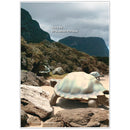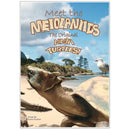Description
Meet the Meiolaniids: The original ninja turtles
Situated 640 kms north-east of Sydney, Lord Howe Island is the eroded remnants of a volcanic seamount that formed around 7 million years ago. Due to its isolation and lack of predators, the Island was a haven for the giant, horned turtle Meiolania which existed on several islands throughout the south-western Pacific during the Holocene Period. Scientists believe that the extinction of these animals on Lord Howe Island may have been a result of habitat loss caused by rising sea levels between ice ages.
In lieu of an abstract, here is a brief excerpt of the content:
Oceanic volcanic islands are special places. They are hard for animals to get to unless they can swim long distances or fly, meaning that they often have similar faunas: lots of birds, a few species of reptiles, few or no mammals (seals and bats often being the only exception), no amphibians, and abundant insects, arachnids and other arthropods. The commonalities between these island faunas can be explained fairly easily: birds, bats and insects can fly; terrestrial reptiles can survive long ocean journeys on rafts of vegetation (whereas mammals can’t); amphibians die when exposed to saltwater; spiderlings can use silk as a parachute to ride on the wind over vast expanses of ocean, and other arthropods can hitch a ride on the feathers of birds. The absence of mammalian predators on these islands gives other animals the opportunity to develop in ways they otherwise might not be able to – they may become large, or flightless or relatively more defenseless. One of the most famous examples of an animal becoming large in island isolation is the Galapagos Tortoise, which approaches half a tonne in mass and achieves lengths close to two metres. However, despite its fame, the Galapagos Tortoise is not the only turtle to have evolved strangely and thrived in isolation.
AAOD Journal Issue 11 (2013) – pages 52 to 65
By Dr Stephen Poropat
This article will be delivered as a PDF to your email and cannot be refunded, returned or cancelled.
Payment & Security
Your payment information is processed securely. We do not store credit card details nor have access to your credit card information.






